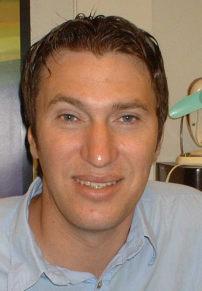Electrostatic Microactuators Fabricated by Vertical Trench Isolation Technology
Promotion Date: 13 May 2005
| This was a part of the micro Scanning Probe Array Memory (microSPAM) project in which three groups participated. The basic idea was to develop a new type of magnetic memory based on microtechnology; small and fast with a low power consumption. The magnetic medium in this memory is placed on tiny squares and accessed with numerous heads underneath, reading and writing the memory in a parallel action. The magnetic medium is subdivided in little squares because each has to turn around very fast, which is easier to accomplish with a several small things than one big one. The job of our group and subject of my thesis was the development of the micromotor to make the memory spin; the motor has to be smaller than one mm2. Because of the demands of small size, large force, large stroke, high speed, low power, high resolution we decided to use the electrostatic shuffle motor principle, the idea of which originated from MESA+. |
What was your thesis about?
This was a part of the micro Scanning Probe Array Memory (microSPAM) project in which three groups participated. The basic idea was to develop a new type of magnetic memory based on microtechnology; small and fast with a low power consumption. The magnetic medium in this memory is placed on tiny squares and accessed with numerous heads underneath, reading and writing the memory in a parallel action. The magnetic medium is subdivided in little squares because each has to turn around very fast, which is easier to accomplish with a several small things than one big one. The job of our group and subject of my thesis was the development of the micromotor to make the memory spin; the motor has to be smaller than one mm2. Because of the demands of small size, large force, large stroke, high speed, low power, high resolution we decided to use the electrostatic shuffle motor principle, the idea of which originated from MESA+. But at that time the motor was not very reliable. We introduced trench isolation to simplify fabrication methods and were able to make a new design of the shuffle motor, resulting in a better performance and substantially improving on reliability.
So the principle of trench isolation is the innovative part?
Yes. A practical realization of micromotors requires fabrication methods that allow an effective electrical insulation between distinct mechanical parts. We employed vertical trench isolation, creating electrical insulation between mechanically joined components in a single material layer. This technology gives more freedom in designing micromotors.
And your motor actually works?
It is in operation here, working fine and going at 80000 steps per second. It is the best performing stepping motor as yet, and also the first one moving in two directions.
What did you like best about your research?
I really enjoyed the freedom in developing your own ideas and work on them as well. You are actually involved from first idea to working device. This implies that you also do a lot of practical work. I like that, because along the way you are getting new ideas. As a result six chapters in my thesis are about the development of the technology, which is the extra that you can only get when you are actually doing the practical work yourself.
And your frustrations?
My frustrations also had to do with the technology, clean room work and other technological processes… In the beginning, it cost a lot of time. I had to familiarize myself with micro technology, which was new to me when I started.
What are you going to do?
I have a contract of two months still to do new measurements with somebody from Control Engineering and on the 16th of July I will start work at University of Tokyo, in the Fujita Lab. Again in the field of Micro- and Nanotechnology and microactuators.
You are not afraid for another culture shock?
Coming from Bosnia I had to get used to the way in which things are done here, and no doubt Japan will be different again. That’s all in the game. Bosnia there is a stronger hierarchy in the academic world, and in Japan as well. At first I had difficulty in getting used to the informal ways of this university, but I must say that I did like it after a while when I noticed that the informality does not interfere with the quality of education and research. I got my motivation from it.
But getting used to another way of life…, as I said: I got used to the way of life here, so Japan will not be a problem.
How did you get here?
I came as a war refugee and finally got a residents permit in 1995. Then I wanted to do something with my life and with a bit of luck, help and a successful entry exam I could start at Twente University. I did not disappoint the ones that put their trust in me and allowed me to start my study here; I graduated with honours.
Is your family still in Bosnia?
Only my parents are. Both my brother and sister are in America.
For the summary of the thesis, click here.

